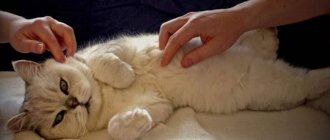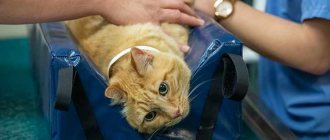How often can you wash your cat?
Cats do not need to be washed daily or weekly; bathing once every 2 months is considered normal.
Watching the cat, it is easy to notice that in her free time from playing and feeding, she likes to “preen” - licking her fur, paws and tail. The animal keeps its fur clean on its own, so it does not need regular bathing. Moreover, too frequent washing can harm the cat, as the pet's subcutaneous glands produce a protective lubricant. The substance is distributed throughout the coat, makes the hair silky, and also serves as a barrier against bacteria. Interesting fact: cats and cats groom themselves differently. Cats spend more time licking their fur and do it more thoroughly than males.
It is important to distinguish between thoroughly washing the cat with shampoo and wiping individual areas of the coat as it gets dirty. If the cat got dirty in the toilet or came home from the street, wipe off the dirt with a soft cloth previously moistened in warm water. This will not harm the pet.
You need to teach a kitten to wash from the age of 4-5 months, so that bathing becomes a habitual ritual, and, as an adult, he would not experience fear of water. In any case, you will have to wash your domestic cat throughout its life, because its fur gets dirty and matted, and you really want the “fur coat” to always be luxurious and well-groomed!
Consequences of non-compliance with temperature indicators
- Hypothermia. Using cold water increases the risk of developing colds. For kitten owners, this is an additional risk of hypothermia (a decrease in body temperature lower than necessary for its normal functioning and metabolism).
- Overheat. A cat's skin is much more sensitive than a human's. Therefore, in hot water the animal runs the risk of overheating or even being burned.
- Dry skin. Cats have their own protective layer on their fur, so if the owner starts washing the animal more often than necessary, he will have another problem - dry skin. You will notice your pet frequently licking itself, scratching itself, or showing other signs of irritation (redness, flaking). To solve the problem, seek help from a veterinarian.
When should you bathe a cat?
It is necessary to bathe a cat only if there are good reasons for doing so. Indications for washing your pet:
- More than 2-3 months have passed since the last bath, and the cat’s fur has become dull, darkened, and matted;
- the cat is very dirty, for example, rolled in the mud or covered in paint;
- If parasites are found in the fur, you need to immediately bathe the cat and then treat the “fur coat” with an antiparasitic agent. You should especially carefully examine cats that are often outdoors and can “catch” ticks and fleas;
- washing may be recommended by a veterinarian if a cat develops allergies, lichen, dermatitis and other skin-related diseases;
- if you find a kitten on the street and decide to take it into the house, then you cannot do without water procedures;
- In preparation for the exhibition, you will have to wash the cat with a special shampoo and give your pet a “styling.”
Breed characteristics
Cats with fur tolerate water procedures comfortably if the water is heated to their body temperature. That is, you can focus on the optimal +38°C.
Sphynx cats have almost no fur, so the animals quickly become hypothermic and even freeze. For these cats, the required temperature is considered to be +39…+40°C.
In any case, it is necessary to monitor the air temperature in the room. For any breed, this indicator should not fall below 23°C.
How to bathe a Sphynx cat
Contraindications for swimming
In some cases, you cannot wash your cat:
- during rehabilitation after surgery. Typically, complete recovery takes about a month, but it all depends on the degree of intervention in the body and the pet’s health condition;
- late pregnancy. Washing can be very stressful for a cat and can even cause premature birth;
- within 2 weeks after vaccination. The cat’s immunity is weakened, and it is better to postpone washing;
- if the animal is sick, bathing can worsen its condition. Cancel water procedures and follow the veterinarian’s recommendations.
When not to swim
There are times when it is not recommended to carry out water treatments for a cat. First of all, this is the period of change of baby teeth in kittens. Until all the teeth are replaced, the pet’s immune system weakens and there is a risk of developing inflammatory processes.
Bathing should be avoided if the cat has recently been vaccinated or the animal is in quarantine. Cats that are weakened after illness and during the acute phase of the disease should also not undergo bathing. After all, most cats are independent and regard water procedures as an interference in their personal space.
It is not advisable to bathe cats during the period of bearing kittens. But if such a need arises, you need to try to minimize the risks of injury to the fetus, thereby preventing problems in the development of future kittens.
Following simple rules during bathing - properly selected shampoo, high-quality drying, encouragement after the procedure - will reduce the appearance of stress in the animal.
Preparing to wash your cat
Trim your cat's nails to prevent him from scratching you while bathing.
Comb the fur and remove tangles.
Choose a place for bathing - a bathtub, sink or basin. The bathtub is perfect for large cats; you just need to cover the bottom with non-slip bedding. Many owners wash their pets in sinks. The option with a basin is less convenient, since the cat may begin to grab onto its edges; give preference to a container with a volume of about 30 liters or buy a special bath.
Remove all foreign objects from the sides of the bathtub or sink, hide washcloths and other things that the cat can get caught on.
Make sure you have everything you need to bathe your pet on hand:
- shampoo selected specifically for cats (laundry soap and detergents are not suitable for humans - cats have a different skin Ph);
- a hat that covers the cat's ears, or cotton swabs that can be placed in the ears, or you can tie a small bag on your head like a scarf;
- soft washcloth for washing hair;
- a large towel in which to wrap the cat after washing so that it does not freeze and cannot scratch you;
- standard towel for collecting remaining moisture and drying;
- caring assistant (preferably).
Check the temperature in the room where you are going to wash your cat. Pets can easily become hypothermic and get sick, so the air should be no colder than +22 °C.
Pour water into the bathtub, basin or sink in advance. The cat is more afraid not of the bath itself, but of the sound of water pouring from the tap. Before starting water procedures, add warm water to a level of about 10 cm so that the water reaches the cat’s belly. The animal must stand confidently on its paws, but so that its head does not get wet. By the way, you can also pre-fill a watering can with water, with which you can then wash off the foam from your pet if he is afraid of the shower. The water temperature should be 38-40 °C. If you don't have a thermometer, place your hand in water up to your elbow. If you do not feel the water, then it is suitable for a cat.
How to properly bathe a kitten for the first time
If you bathe a small kitten correctly for the first time, he will not develop negative associations with this procedure. Therefore, it is so important that washing is as comfortable as possible.
Felinologists recommend adhering to the following rules:
- Do not bathe your cat after eating. Only a light snack is acceptable, but it is better to wash your pet on an empty stomach.
- It is advisable that the kitten bathe during the molting period. Washing will make the process easier, and the animal will not accumulate a lot of hair in its stomach.
- Before bathing your pet, carefully comb the fur coat and untangle the tangles. To prevent the kitten from scratching, it is advisable to shorten the claws.
- The bathroom should be protected from drafts.
- To wash your kitten for the first time, it is better to use unscented shampoo.
- At first, it is better to bathe the kitten with an assistant. One person will hold the baby, the other will perform the necessary manipulations.
- The water should not be too cold or hot. Optimum temperature +38…+40°C.
- The ears are plugged with cotton to prevent water from getting into them. If this happens, inflammation may develop.
- It is better to wet your head not with a stream of water, but with a damp sponge.
It is recommended to wash the kitten for the first time not in the bath itself, but in a small basin. This will make it easier to hold him, and the pet will feel more confident. To prevent the paws from slipping, place a rubber mat on the bottom of the container.
For your information. It is not advisable to bathe a kitten in a sink. He can escape, fall from a great height and get injured.
All necessary equipment - detergent, towels, treats, etc. - should be at hand. If your pet scratches a lot, you should take care of rubber gloves. They will protect your hands from sharp claws.
When all preparations are completed, the kitten is gradually immersed in water approximately up to the shoulders. You can allow him to hold on to the edge of the basin and at the same time pour water on him. To bathe your pet without scaring it, talk to the baby in a gentle voice during the process. A friendly intonation makes it clear that there is no threat.
Shampoo is diluted in a separate container in the required concentration and applied to the kitten’s body. The soap solution is carefully distributed with massaging movements, being careful not to wet your head. Particular attention is paid to:
- armpits;
- stomach;
- areas around the genitals;
- paws;
- places behind the ears.
More dirt accumulates here. If your pet is bathed with an antiparasitic agent, the neck is treated first to prevent fleas from escaping to the head.
Leave the shampoo on the fur for the time specified in the instructions, and then rinse the kitten with plenty of water. It is better to water the baby from a mug or wet the fur with the palm of your hand than to use a tap or shower - a powerful stream will scare the pet.
At the end, the fluffy is generously praised and treated to his favorite treat to reinforce positive associations.
How to properly wash a cat
Before the water gets cold and the cat suspects something is wrong, grab her and take her to the bathroom. Talk to your purr gently, do not make sudden movements that could frighten your pet. Don't forget to close the door - if the cat escapes, it will be difficult to catch, and wet paw marks will remain all over the apartment (possibly along with foam, if you manage to soap the cat).
Gently place the cat in the bathtub, basin or sink. During the dive, you can hold it by the scruff of the neck to prevent the pet from breaking free and scratching you. Put a bathing cap on him or put cotton swabs in his ears. Run warm water over the fur, avoiding the eyes, nose and ears.
It is likely that the cat will be unhappy and begin to resist. She will have to be persistent - for her own good. Grasp the cat's shoulders directly under your chest in your left hand if you are right-handed. This way, your dominant hand will remain free and can be used to lather the animal. If the cat is waving its hind legs, then you just need to sit it down and hold it so that it cannot jump and kick.
At this stage, the assistant will make your task much easier - he can water the cat from a watering can or shower, supply shampoo, a towel and other necessary items, and you will do all the manipulations with your free hand.
Note: pet stores suggest using a short leash with suction cups to bathe your cat. This accessory makes sense to use only as a last resort, since the pet may be more afraid of the leash than the washing, and in the future it will be difficult to lure the cat into water treatments.
Now apply shampoo to the wet cat's fur with light massaging movements. Consistently soap your back, chest, belly and tail, don’t forget about your paws and chin. Do not use too much shampoo so that you do not have to wash off the foam for a long time.
Using a special washcloth, gently wash the cat's face. If you want to wash your cat's hair, ask an assistant to pinch his ears or put cotton swabs in them. Also make sure that water does not get into your cat's nose.
It's time to thoroughly rinse your cat's fur. Rinse off the foam strictly from top to bottom. It is convenient to wash off the shampoo with a hand shower, just do not lift it very high. Residues of detergent should not remain on the cat's skin, as this may subsequently lead to irritation.
If you rinse your pet's fur using a basin, consider its length. For a short-haired cat, one basin will be enough, while for a long-haired cat, several.
Important: you should not wash your cat after feeding or immerse it in water with its head.
When the shampoo is rinsed, remove the purr from the water, wrap it in a large towel and hug your “cocoon” for a few minutes. The cat should come to its senses and calm down.
Contraindications to bath procedures
There are situations when it is absolutely forbidden to bathe kittens. These include:
- Illness - avoid water procedures until complete recovery.
- Vaccination – bathing kittens is prohibited for 14 days after vaccination.
- Ringworm - along with water, the infection will spread to other parts of the body.
- Surgery – After surgery, cats are not bathed until the stitches have healed.
- Severe stress - water procedures will only aggravate the condition.
Drying wool after bathing
Take the freshly washed cat into the room and dry it with a towel. For short-haired cats, one towel will be enough, and for long-haired cats, do not skimp on 2-3 pieces. You can place your pet on a newspaper or hoe so that the dripping moisture is absorbed faster.
For your information: a cat has a so-called air cushion between its skin and the top layer of fur. This layer of air is heated by the animal's body heat and protects the cat from freezing. During bathing, the fur gets wet and temporarily loses its thermoregulatory properties, which is why it is so important to warm the cat with towels after washing and protect it from drafts.
If the cat is not afraid of a hair dryer, then about 10 minutes after bathing you can lightly dry his fur. The air flow should be warm, but not hot. If the cat is afraid of electrical appliances, it is better to wait until the “coat” dries naturally.
Use a special comb to comb the fur.
After washing, your domestic cat needs to stay warm for at least an hour.
When to bathe a cat
If a cat lives at home, this does not mean that he needs to be bathed often. It is necessary to bathe an animal when it is really necessary.
So, when is it necessary to bathe a cat:
If the wool is dirty. The fur of a healthy cat is rarely dirty or greasy, even when kept indoors. But sometimes it happens that the wool is really dirty. The cat got dirty in a puddle, jumped into fatty soup, and so on. Naturally, you cannot do without additional hygiene.
If your cat has parasites on his fur. For example, fleas. Special shampoos are used to remove them.
In spring during molting. Bathing helps rid the animal of excess undercoat. This way, when licking, excess hair will not get into your pet's stomach. This will protect you from the formation of hairballs in your stomach (bezoars). In fact, it is for this purpose that you need to bathe the animal as planned.
After the haircut. If you are grooming a cat, you need to bathe him after grooming to remove excess hair.
If the cat cannot cope with cleaning the fur on its own. Some cats are not very clean, rarely groom themselves, for this reason the fur becomes greasy and begins to smell unpleasant due to excessive amounts of sebum.
But pay attention - if your cat licks himself often and cannot be called unclean, but his fur still quickly becomes dirty and looks greasy, it is better to see a veterinarian. Perhaps the animal has some kind of disease (for example, oily seborrhea)
In this case, you first need to treat and then bathe the cat. You may need special medicated shampoos.
Many people ask the question: how often do you need to bathe a cat? It is enough to do this 2 times a year. In spring and early autumn. During this period, cats shed the most heavily.
How to wash a cat that is afraid of water
What to do if your cat is afraid of water? Do you really have to give up bathing completely? This problem can be solved - be patient and smart.
Firstly, do not neglect trimming their nails before washing, because during bathing, especially impressionable cats become very belligerent.
Then play with your cat thoroughly to get him relaxed and tired. You cannot feed your pet.
Having lulled the mustache-striped vigilance, start washing. You need to lower your cat into the water gradually, distracting him with toys. Water should be poured in advance so that the cat does not wait extra time and is not afraid of the unusual sound.
No matter how the cat behaves while washing, there is no need to yell at it or physically punish it - this will only bring additional stress to the animal. To limit movement, you can use a special bathing net, where the cat is placed, like in a bag, and does not go anywhere. Maybe it will remind him of his favorite box?
After finishing washing, treat your cat with a treat - this way she will know that there is a reward waiting for her for bathing!
If your pet still cannot overcome its panic fear of water, you can wash it with dry shampoo. This is a great alternative to traditional shampooing because a good dry shampoo cleans almost as well as a liquid shampoo. Apply the powder to the cat's fur, wait a minute and brush the powder and dirt out.
“Tactics” for training a cat to use the bathroom
Before teaching a cat not to be afraid of water, you need to overcome all the accompanying discomfort. Carry the animal into the bathroom in your arms; if the cat does not strain, try turning on the water for a short time. Calm your cat down, let him know that he is protected, but be prepared, the sound of running water can throw the cat into panic.
Try putting the animal in a dry bath; most likely, the pet will immediately run away, but this is only the first stage. Agree with your pet, do not try to wet the fur or force the cat not to be afraid, forcing events will only add to the hassle. Gradually, patiently, agreeing to the animal’s conditions and that’s the only way!
Important! Bathroom lighting is a separate issue. It has been established that animals experience fear if there is not enough light in the room. Change the light bulbs to brighter ones or install an additional light above the bathroom while you study.
Naturally, it is easier to accustom a kitten to water; the little one who unconditionally trusts you will accept or at least tolerate water procedures after 3-4 “training swims”. It is difficult, sometimes impossible, to train an adult cat. If your pet doesn't go outside, it's easier to give him a quick bath than to torment him for months of training.
How to wash your cat's eyes and ears
So, even the most capricious cat was washed, but during bathing we went around the eyes and ears, and they should also be clean.
The cat's eyes are wiped with a cotton swab dipped in clean boiled water or a weak solution of tea or chamomile. Movements should be light, no need to press or rub your eyes.
It's time for ears. There is no need to clean them unless they become dirty. However, after washing the cat, water could get into the ears. You need to wipe the outer part of the ear with a cotton swab, on which it is better to twist an additional layer of cotton wool. Use a clean stick or dip it in a drop of Vaseline oil. Water and other liquids cannot be used. As a rule, cats love to clean their ears and are happy to present them to their owner. Healthy cat ears should be pink, clean, and free of unpleasant odor.
How to wash a cat?
Under no circumstances should you use regular soap or human shampoo. Today there are special zoo shampoos on sale, and they are:
- dry;
- in the form of a spray;
- liquid.
Dry shampoo is the best option as it is easy to apply to the coat. After a certain time, the powder is simply combed off, and all the dirt is removed along with it. In terms of effectiveness and safety, it is not inferior to conventional liquid shampoos, and also makes combing easier. It will be an excellent solution if the animal has a panic fear of water. Another advantage of using a dry product is that the wool will be dry and does not need to be dried. When dry washing, do not be afraid of water getting into your ears and eyes. Excellent for frequent washing, because they do not damage the fat layer and do not dry out the skin.
The principle of operation of a spray shampoo is the same as a dry product. Sprays are not very common, so purchasing them in a store is not so easy, even despite their ease of use. Unlike dry sprays, they can provide antistatic protection to wool. They make combing easier, which is important for animals with long hair. It should also be taken into account that the sprays have a fairly persistent and pronounced aroma.
Liquid products do an excellent job of removing different types of dirt and make the coat smooth and silky. There are specialized shampoos that help deal with ticks, fleas, etc. By the way, medicated shampoos can be used no more than 1-3 times a year, as they disrupt the functioning of the sebaceous glands. Liquid shampoos are considered the most popular and this is not in vain, because they can easily cope with tangles, severe dirt and small parasites.
Features of washing cats of different breeds
Some purebred cats have coat characteristics that affect their care. In general, we can say that long-haired cats need to be washed more often than short-haired cats.
A common myth concerns Sphynx cats - supposedly because of their oily skin they need to be washed once a week. In fact, it is better to wipe the Sphynx with wet wipes or a soft cloth, and bathe it only if it is very dirty.
The Burmese cat has a very impressive, shiny, short coat, the beauty of which must be maintained. Instead of washing fine fur, which can make your cat look like a hedgehog, wipe it daily with a piece of suede or a damp cloth. This will help give the “fur coat” a glossy shine. Once a week, the cat should be combed with a mitten or brush. You can use a special cat antistatic agent. Your chocolate will definitely love this massage!
British cats and Maine Coons have sensitive skin, so it is extremely important for them to select specialized shampoos based on their coat type. From low-quality cosmetics, cats can begin to constantly itch and develop dandruff.
Bathing a cat before a show
Before participating in the exhibition, any domestic cat will have to be washed. Such bathing will have some features:
- You need to wash the cat twice before the exhibition; during the second wash, use a tinted shampoo (or balm) selected depending on the color;
- the foam is also washed off 2 times, first with water, then with a rinse aid or a weak solution of vinegar;
- while drying with a hairdryer, the wool is smoothed with a massage comb with antistatic teeth, starting from the back and ending with the collar;
- Now you can apply powder to the still slightly damp “fur coat”, which will absorb the remaining moisture and make the coat smooth;
- After a couple of hours, finish treating your cat's fur by applying a protein conditioner.
Life hack: how to choose a tinted shampoo for cats of different colors
White pets are washed 2 or even 3 times with shampoo intended for white cats. When reapplying, leave the shampoo on for 2 minutes for a deeper effect, and then be sure to rinse well. White shampoo is also suitable for chinchilla and silver marbled cats, but there is no need to leave the detergent on the coat. If a cream, blue or lilac cat seems a bit dark to you, use the same shampoo to create a lighter, brighter shade.
Cats with rare red, tortoiseshell and merle colors should be washed with red or bronze shampoo. If your cat has a chocolate-colored coat, add a few drops of black to the bronze shampoo. Black shampoo is suitable for fluffy beauties of black colors.
Follow the instructions, and your cat will outshine all its relatives at the show!
Wash water temperature
To ensure proper care of the fur, you need to know what temperature is suitable for your cat when bathing. It is determined depending on the characteristics of the breed.
Many animals are thermophilic, so cold water can be dangerous to a cat’s health and immunity. Hot water can burn the skin, frightening your pet and leaving a burn. For simple breeds, an average temperature of 38-39°C is suitable; if the cat feels chills or tries to sneak away, you can increase the temperature to 40 degrees.
When bathing, you need to use special products that are designed specifically for animals. Some gels and shampoos for humans may not be suitable for cats, which can cause irritation, itching and redness of the skin. They also dry out the fur and take longer to wash off with water.











